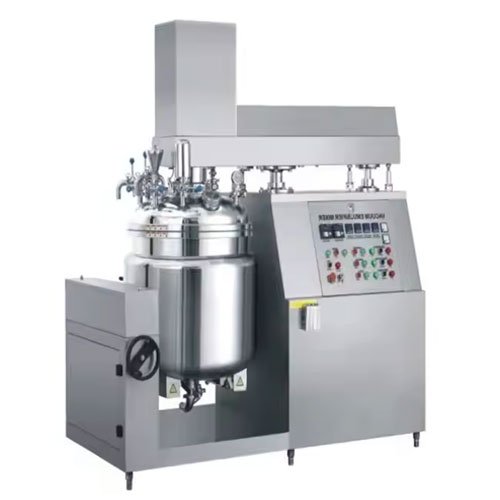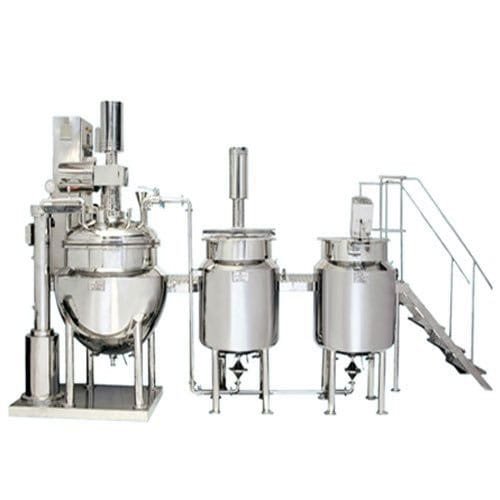This machine is made of: main working tank, water tank, oil tank, vacuum homogogenous emulsifying, hearting system, mixing system, electrical lifting system, operation control cabinet, piping system. It is the ideal machine for production of cosmetics, pharmacy, food or chemicals and other products. Vacuum emulsifying mixers come in various types and configurations based on their intended application and the specific requirements of the product being manufactured. Here’s a more detailed breakdown of the different types and key components of vacuum emulsifying mixers:
Types of Vacuum Emulsifying Mixers:
Laboratory-Scale Vacuum Emulsifying Mixer:
- Purpose: Designed for research and development or small-scale production.
- Capacity: Typically has a smaller capacity (usually from 1 to 20 liters).
- Features: Offers precise control over mixing, temperature, and vacuum levels. Often used for testing formulations before scaling up to larger production volumes.
- Applications: Ideal for cosmetic R&D, small batch testing, and pilot productions.
Pilot-Scale Vacuum Emulsifying Mixer:
- Purpose: For medium-scale production and testing on a larger scale before full commercial manufacturing.
- Capacity: Usually ranges from 50 to 200 liters.
- Features: Similar to laboratory models but designed for higher throughput and more robust operation. Provides more automation and better scalability options.
- Applications: Used by businesses that need to test their formulations at a larger scale before moving into mass production.
Industrial-Scale Vacuum Emulsifying Mixer:
- Purpose: Designed for full-scale manufacturing and large-volume production.
- Capacity: Can range from 200 liters to several thousand liters.
- Features: High throughput, automated, and often with advanced control systems for precise monitoring of mixing speed, temperature, and vacuum. These machines are capable of continuous or batch production.
- Applications: Used in industries like cosmetics, pharmaceuticals, and food for large-scale production of emulsions.
Key Components of a Vacuum Emulsifying Mixer:
Vacuum Chamber:
- The heart of the machine where the actual mixing and emulsifying happen. The vacuum chamber ensures that air is removed from the mixture to prevent the formation of air bubbles. This leads to smooth, stable emulsions.
- The chamber is typically made of stainless steel for easy cleaning and durability.
High-Shear Homogenizer (Rotor-Stator Assembly):
- Rotor: The rotor is a rapidly spinning component that draws materials into the stator.
- Stator: The stator is a stationary part with slits or holes that work in combination with the rotor to create intense shear forces that break down larger particles into smaller ones, allowing for better mixing.
- The rotor-stator assembly creates a high shear environment that helps to disperse one phase (typically the oil phase) into another phase (typically the water phase), forming an emulsion.
Mixing Shaft:
- The shaft is responsible for rotating and stirring the ingredients in the vacuum chamber. The shaft typically drives the high-shear homogenizer and other mixing components.
- It can have multiple mixing heads or paddles, depending on the model, to ensure thorough blending of ingredients.
Heating and Cooling Jackets:
- These are often integrated into the mixer’s design to heat or cool the material during processing. This is crucial for products that need to be emulsified at specific temperatures, like emulsions of oils, fats, or certain active ingredients that require heat for proper solubilization.
- Heating: The jacket can be heated with hot water or steam.
- Cooling: It can also be cooled by circulating cold water or air to control the temperature of the mixture.
Vacuum Pump:
- A vacuum pump is used to create the vacuum environment within the chamber. The vacuum removes air and other gases from the mixture, which helps to produce a smooth emulsion and prevents the trapping of air bubbles.
- The pump typically works in tandem with a pressure gauge to monitor and control the level of vacuum.
Control Panel and Automation:
- The control panel allows operators to set and adjust parameters such as the mixing speed, temperature, and vacuum levels. Some advanced models have automated systems that continuously monitor and adjust the process to maintain optimal production conditions.
- Modern systems can be equipped with touch screens, PLC (Programmable Logic Controller) interfaces, and even remote monitoring options.
Discharge Valve:
- After the mixing and emulsifying process is complete, the final product needs to be discharged from the mixer. This is typically done through a discharge valve located at the bottom of the vacuum chamber.
- The valve may include a bottom discharge or a rotating valve system, depending on the design.
Cooling System:
- After emulsification, some products require rapid cooling to stabilize the emulsion and prevent separation. A dedicated cooling system, such as a water-cooled jacket or an integrated chiller, ensures the temperature is brought down quickly.
Homogenizing Pump (in some models):
- Some vacuum emulsifying mixers include an additional homogenizing pump that further improves the consistency of the emulsion by applying additional shear force, which is especially important for high-viscosity formulations.
Benefits of Different Features:
- High-Shear Mixing: Ensures fine, uniform emulsions with small particle sizes, which are important for the smooth texture and stability of the product.
- Vacuum Technology: Prevents the inclusion of air in the product, ensuring the stability of the emulsion and preventing issues like foaming or bubbles in cosmetic products.
- Temperature Control: Allows for precise control over the emulsion process, which is essential for handling heat-sensitive ingredients.
- Automation: Modern machines can automate many aspects of the process, improving efficiency, consistency, and reducing human error.
Applications for Each Industry:
- Cosmetics & Skincare: For producing creams, lotions, emulsions, gels, and serums. The vacuum emulsifying mixer allows for the incorporation of various active ingredients, such as anti-aging compounds, moisturizers, and exfoliants, into a stable emulsion without air inclusion.
- Pharmaceuticals: In the production of creams, ointments, lotions, and gels that are applied topically, ensuring the active ingredients are well-dispersed and effective.
- Food & Beverage: Used for emulsifying ingredients in products like mayonnaise, dressings, sauces, ice cream, and spreads, ensuring smooth, stable emulsions and preventing separation.
- Chemicals: In the manufacturing of paints, coatings, adhesives, and lubricants where a stable, uniform consistency is crucial for product performance.
Characteristic:
- The mixing system is designed for manufacturing creams and liquids with different features;
- The speed of mixing and homogenizing system can be adjusted according to the different process technologies.
- The digital time and temperature indicator are settled on the control cabinet. User will detect the working time and temperature easily;
- Homogenizing is processed by CNC lathe and applies German technology to achieve fine and smooth material;
- Vacuum system makes the whole operation in the vacuum condition so that there is no bubbles in material.
How it works:
- Vacuum Environment: The vacuum function removes air from the mixing chamber, preventing air bubbles from being trapped in the mixture. This is crucial for creating stable emulsions and ensuring smooth textures without the inclusion of air pockets that could affect the quality of the product.
- High Shear Mixing: The machine utilizes a high-shear mixing system, often with a rotor-stator mechanism, to create strong shear forces that break down larger particles and blend them into a fine, stable mixture. This process is essential for producing fine emulsions that have a consistent texture.
- Heating and Cooling: Many vacuum emulsifying mixers have a temperature control system that can heat or cool the mixture during the emulsification process. This is particularly important for products that need to be emulsified at specific temperatures, such as creams, lotions, or certain pharmaceutical products.
- Efficient Mixing of Ingredients: The machine typically handles both liquid and solid ingredients, making it versatile for various formulations. It allows for the precise addition of ingredients like oils, surfactants, stabilizers, and active ingredients.
Benefits:
- Stable Emulsions: Produces highly stable emulsions with longer shelf life.
- Enhanced Product Quality: Prevents air bubbles and ensures smoother, uniform consistency in the final product.
- Speed and Efficiency: Significantly reduces production time compared to traditional mixing methods.
- Precise Control: Offers temperature and vacuum control, allowing precise formulation and ensuring product quality.









